An Improved Method for Urban Built-Up Area Extraction Supported by Multi-Source Data
Abstract
:1. Introduction
2. Related Work
2.1. Existing Methods
- (1)
- Road density adjusted NTL extraction methodBased on the a priori knowledge that the impervious surfaces and UBUAs of a city are negatively correlated with vegetation and positively correlated with the road density, a REANI index that considers road density and EVI was proposed [22].where denotes the min–max normalized road density of point I and () is the min–max normalized value of point i within the range of [0,1].
- (2)
- POI adjusted the extraction methodAs one of the basic data types for urban spatial analysis, POIs can intuitively and effectively reflect the spatial patterns of various urban elements. Based on the spatial distributions of POIs, urban spatial structures and urban factors, existing studies have integrated the POI density with data to extract UBUA boundaries [25].where represents the intensity at the i-th point and denotes the POI kernel density at the i-th point.
2.2. Limitations of the Current Methods
3. EVI, POI and Road Network Adjusted NTL Urban Index for Urban Built-Up Area Extraction
3.1. PREANI Index: The EVI, POI and Road Network Adjusted NTL Urban Index
3.1.1. NTL Data Processing Model
3.1.2. POIs and Road Kernel Density Calculation
3.1.3. Data Normalization
3.1.4. Adjusted NTL Index (PREANI) Construction
3.2. Dynamic Threshold Method
4. Experiment Analysis and Discussion
4.1. Experimental Data
4.2. Overall Accuracy Analysis
4.3. Local Accuracy Analysis
- (1)
- Comparison with the road density-based method (low road density and high POI density scenario).
- (2)
- Comparison with the POI-based method (high road density and low POI density scenario)
4.4. Quantitative Analysis
5. Discussion
5.1. Advantages of Urban Built-Up Area by PREANI
5.2. Applications of the Proposed Method
5.3. The Methodological Implications: Choose the Appropriate Approaches
5.4. Limitations and Future Reseach
6. Conclusions
- (1)
- With regard to the overall accuracy, the UBUA boundaries extracted by the proposed method are highly consistent with the reference UBUA boundaries. Through difference comparisons, 22 differences between the proposed method and the road density-based method and 17 differences between the proposed method and the POI-based method were identified.
- (2)
- For local accuracy, UBUA extraction based on the proposed method is superior to that with existing methods in the areas with low POI densities and high road densities (e.g., new industrial areas) and the areas with low road densities and high POI densities (e.g., urban–rural transition zones). However, our method may have limitations in the areas with low road and POI densities.
- (3)
- Quantitative analysis showed that the recall values of built-up area extraction for both the proposed and POI-based methods are above 80%. However, in terms of the precision and F1 score, the proposed method yields values that are superior by at least 4% and 0.04, respectively, to those of the other methods, demonstrating that the proposed method considerably outperforms the existing method in terms of UBUA extraction accuracy.
Author Contributions
Funding
Institutional Review Board Statement
Informed Consent Statement
Conflicts of Interest
References
- He, C.; Shi, P.; Xie, D.; Zhao, Y. Improving the normalized difference built-up index to map urban built-up areas using a semiautomatic segmentation approach. Remote Sens. Lett. 2010, 1, 213–221. [Google Scholar] [CrossRef] [Green Version]
- Wang, L.; Zhu, J.; Xu, Y.; Wang, Z. Urban Built-Up Area Boundary Extraction and Spatial-Temporal Characteristics Based on Land Surface Temperature Retrieval. Remote Sens. 2018, 10, 473. [Google Scholar] [CrossRef] [Green Version]
- Li, Q.; Zheng, B.; Tu, B.; Yang, Y.; Wang, Z.; Jiang, W.; Yao, K.; Yang, J. Refining Urban Built-Up Area via Multi-Source Data Fusion for the Analysis of Dongting Lake Eco-Economic Zone Spatiotemporal Expansion. Remote Sens. 2020, 12, 1797. [Google Scholar] [CrossRef]
- Li, Y.; Sun, Q.; Ji, X.; Xu, L.; Lu, C.; Zhao, Y. Defining the Boundaries of Urban Built-up Area Based on Taxi Trajectories: A Case Study of Beijing. J. Geovisualization Spat. Anal. 2020, 4, 8. [Google Scholar] [CrossRef]
- Rizeei, H.; Pradhan, B.; Saharkhiz, M. Urban object extraction using Dempster Shafer feature-based image analysis from worldview-3 satellite imagery. Int. J. Remote Sens. 2019, 40, 3. [Google Scholar]
- Cheng, F.; Liu, S.; Hou, X.; Zhang, Y.; Dong, S.; Coxixo, A.; Liu, G. Urban Land Extraction Using DMSP/OLS Nighttime Light Data and OpenStreetMap Datasets for Cities in China at Different Development Levels. IEEE J. Sel. Top. Appl. Earth Obs. Remote Sens. 2018, 11, 1–13. [Google Scholar] [CrossRef]
- Tan, J.; Zhang, M.; Tan, X. Methods for Extracting Urban Construction Land Using Night-Light Data: Assessment and Application. In Proceedings of the 2018 26th International Conference on Geoinformatics, Kunming, China, 28–30 June 2018; pp. 1–4. [Google Scholar]
- Yu, B.; Tang, M.; Wu, Q.; Yang, C.; Deng, S.; Shi, K.; Peng, C.; Wu, J. Urban Built-Up Area Extraction from Log- Transformed NPP-VIIRS Nighttime Light Composite Data. IEEE Geosci. Remote Sens. Lett. 2018, 15, 1279–1283. [Google Scholar] [CrossRef]
- Ou, J.P.; Liu, X.P.; Liu, P.H.; Liu, X.J. Evaluation of Luojia 1-01 nighttime light imagery for impervious surface detection: A comparison with NPP-VIIRS nighttime light data. Int. J. Appl. Earth Obs. Geoinf. 2019, 81, 1–12. [Google Scholar] [CrossRef]
- Liu, X.; Hu, G.; Ai, B.; Li, X.; Shi, Q. A normalized urban areas composite index (NUACI) based on combination of DMSP/OLS and MODIS for napping impervious surface area. Remote Sens. 2015, 7, 17168–17189. [Google Scholar] [CrossRef] [Green Version]
- Wang, R.; Wan, B.; Guo, Q.; Hu, M.; Zhou, S. Mapping Regional Urban Extent Using NPP-VIIRS DNB and MODIS NDVI Data. Remote Sens. 2017, 9, 862. [Google Scholar] [CrossRef] [Green Version]
- Hsu, F.C.; Baugh, K.E.; Ghosh, T.; Zhizhin, M.; Elvidge, C.D. DMSP-OLS radiance calibrated nighttime lights time series with intercalibration. Remote Sens. 2015, 7, 1855–1876. [Google Scholar] [CrossRef] [Green Version]
- Tselios, V.; Stathakis, D. Exploring regional and urban clusters and patterns in Europe using satellite observed lighting. Environ. Plan. B Urban Anal. City Sci. 2020, 47, 553–568. [Google Scholar] [CrossRef]
- Duque, J.; Lozano-Gracia, N.; Patino, J.; Restrepo, P.; Velasquez, W.A. Spatiotemporal dynamics of urban growth in Latin American cities: An analysis using nighttime light imagery. Landsc. Urban Plan. 2019, 191, 103640. [Google Scholar] [CrossRef]
- Pandey, B.; Joshi, P.K.; Seto, K.C. Monitoring urbanization dynamics in India using DMSP/OLS night time lights and SPOT-VGT data. Int. J. Appl. Earth Obs. Geoinf. 2013, 23, 49–61. [Google Scholar] [CrossRef]
- Li, F.; Yan, Q.; Zou, Y.; Liu, B. Improving the accuracy of built-up area extraction based on nighttime light data and POI: A case study of NPP/VIIRS and Luojia 1-01 nighttime light images. Geomat. Inf. Sci. Wuhan Univ. 2021, 1–14. [Google Scholar]
- Sharma, R.; Tateishi, R.; Hara, K.; Gharechelou, S.; Iizuka, K. Global mapping of urban built-up areas of year 2014 by combining MODIS multispectral data with VIIRS nighttime light data. Int. J. Digit. Earth 2016, 9, 1–17. [Google Scholar] [CrossRef]
- Min, X.; Chunyang, H.; Zhifeng, L.; Dou, Y. How did urban land expand in China between 1992 and 2015. A multi-scale landscape analysis. PLoS ONE 2016, 11, e0154839. [Google Scholar]
- Zhuo, L.; Zhang, X.; Zheng, J.; Tao, H.; Guo, Y. An EVI-based method to reduce saturation of DMSP/OLS nighttime light data. Acta Geogr. Sin. 2015, 70, 1339–1350. [Google Scholar]
- Zhang, X.Y.; Li, P.J. A temperature and vegetation adjusted NTL urban index for urban area mapping and analysis. ISPRS J. Photogramm. Remote Sens. 2018, 135, 93–111. [Google Scholar] [CrossRef]
- Zheng, Z.; Chen, X.; Wu, Z.; Zhang, Q. Method to reduce saturation of DMSP/OLS nighttime light data based on UNL. J. Remote Sens. 2018, 22, 161–173. [Google Scholar]
- Yan, Q.; Li, F.; Li, L. Research on built-up area extraction via brightness correction indexes based on two kinds of nighttime light images. J. Geo-Inf. Sci. 2020, 22, 1714–1724. [Google Scholar]
- He, X.; Zhou, C.; Zhang, J.; Yuan, X. Using Wavelet Transforms to Fuse Nighttime Light Data and POI Big Data to Extract Urban Built-Up Areas. Remote Sens. 2020, 12, 3887. [Google Scholar] [CrossRef]
- Xu, Z.; Gao, X. A novel method for identifying the boundary of urban built-up areas with POI data. Acta Geogr. Sin. 2016, 71, 928–939. [Google Scholar]
- Li, F.; Yan, Q.; Bian, Z.; Liu, B.; Wu, Z. A POI and LST adjusted NTL urban index for urban built-up area extraction. Sensors 2020, 20, 2918. [Google Scholar] [CrossRef]
- Mao, J.; Yan, X. A study to the impacts on urban land use of transport system in highly-densely developed city—A case study of Guangzhou. Econ. Geogr. 2005, 25, 185–188+210. [Google Scholar]
- Li, B. Layout evolution and optimization of Dongying central city. Urban Rural Dev. 2015, 3, 43–45. [Google Scholar]
- Li, S.; Dragicevic, S.; Castro, F.A.; Sester, M.; Winter, S.; Coltekin, A.; Pettit, C.; Jiang, B.; Haworth, J.; Stein, A. Geospatial big data handling theory and methods: A review and research challenges. ISPRS J. Photogramm. Remote Sens. 2016, 115, 119–133. [Google Scholar] [CrossRef] [Green Version]
- Li, C.; Liu, L.; Dai, Z.; Liu, X. Different Sourcing Point of Interest Matching Method Considering Multiple Constraints. ISPRS Int. J. Geo-Inf. 2020, 9, 214. [Google Scholar] [CrossRef] [Green Version]
- Lou, G.; Chen, Q.; He, K.; Zhou, Y.; Shi, Z. Using Nighttime Light Data and POI Big Data to Detect the Urban Centers of Hangzhou. Remote Sens 2019, 11, 1821. [Google Scholar] [CrossRef] [Green Version]
- Lüscher, P.; Weibel, R. Exploiting empirical knowledge for automatic delineation of city centres from large-scale topographic databases. Comput. Environ. Urban Syst. 2013, 37, 18–34. [Google Scholar] [CrossRef] [Green Version]
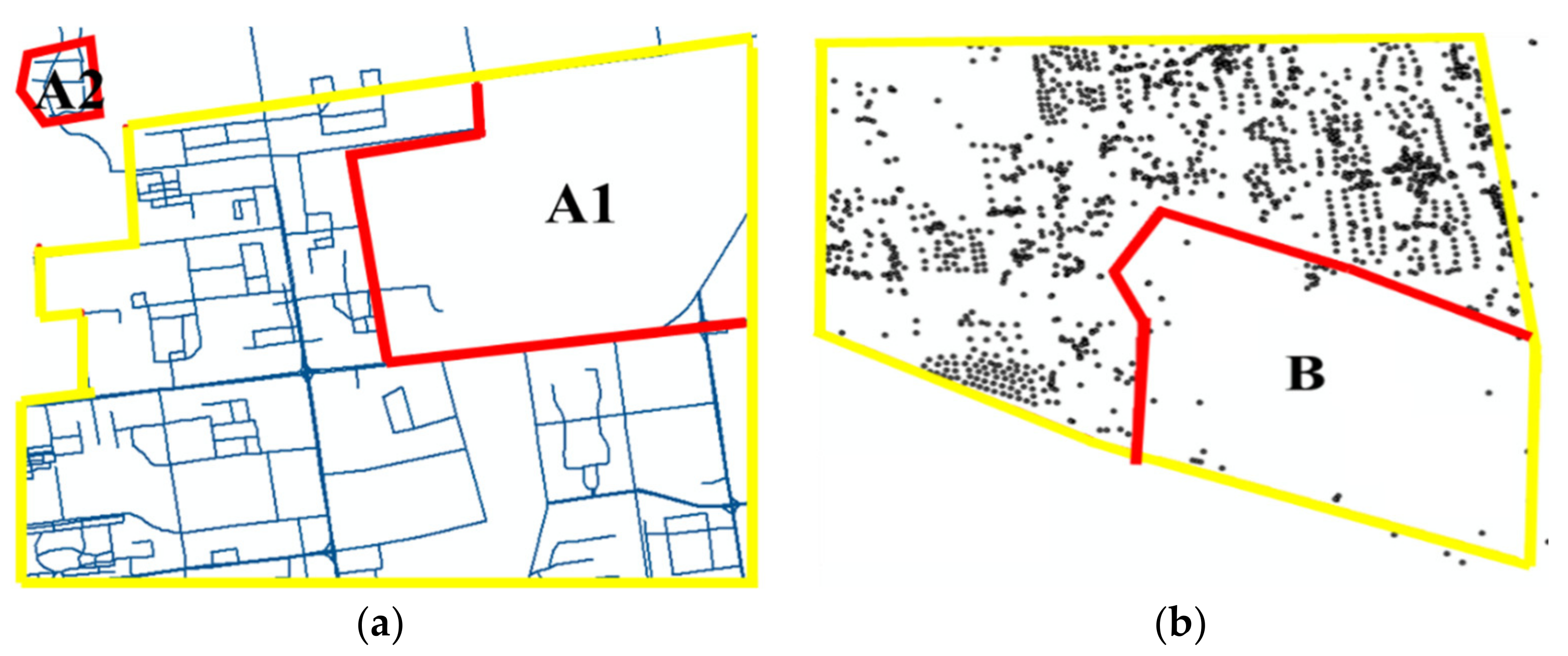
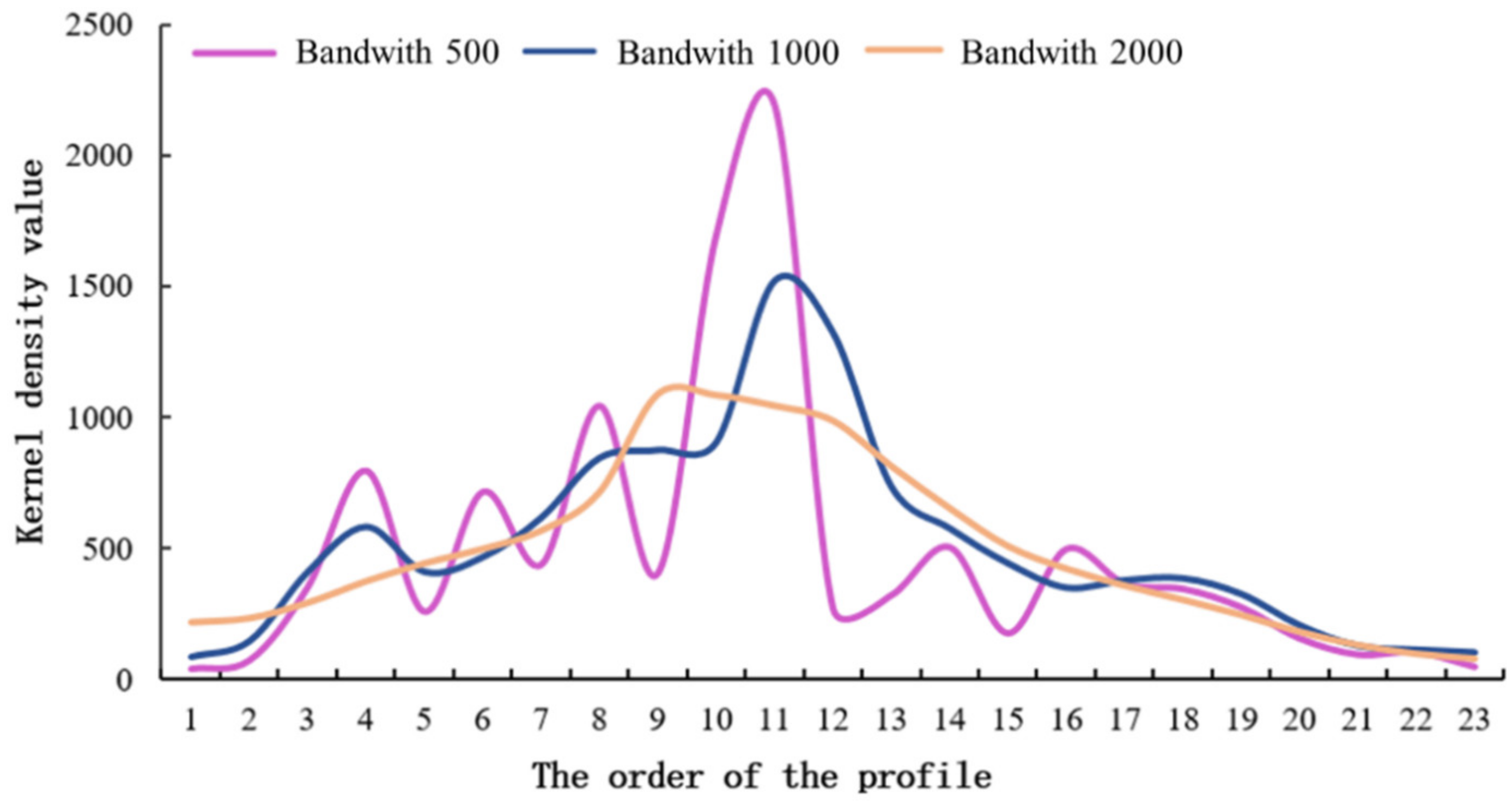
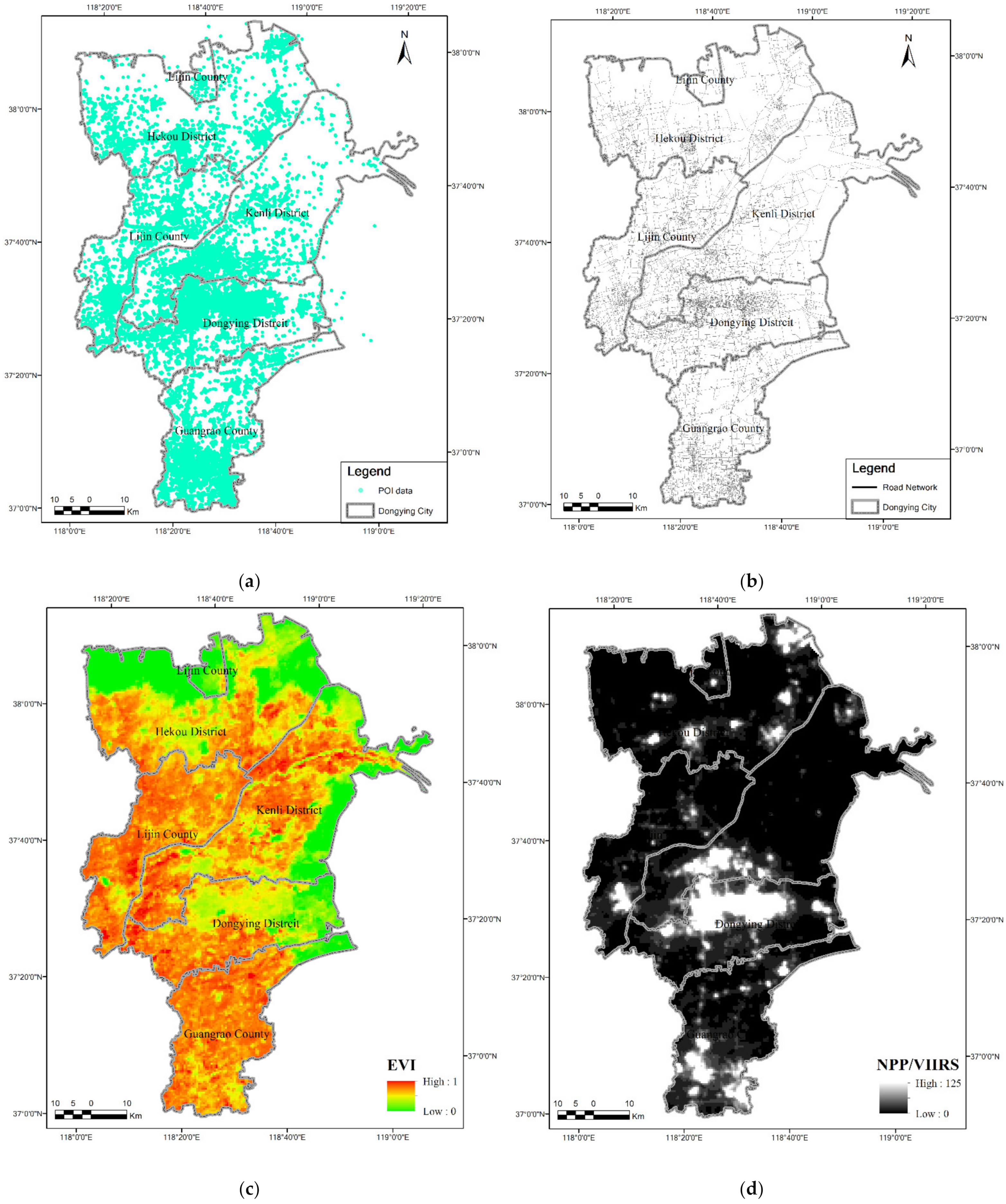
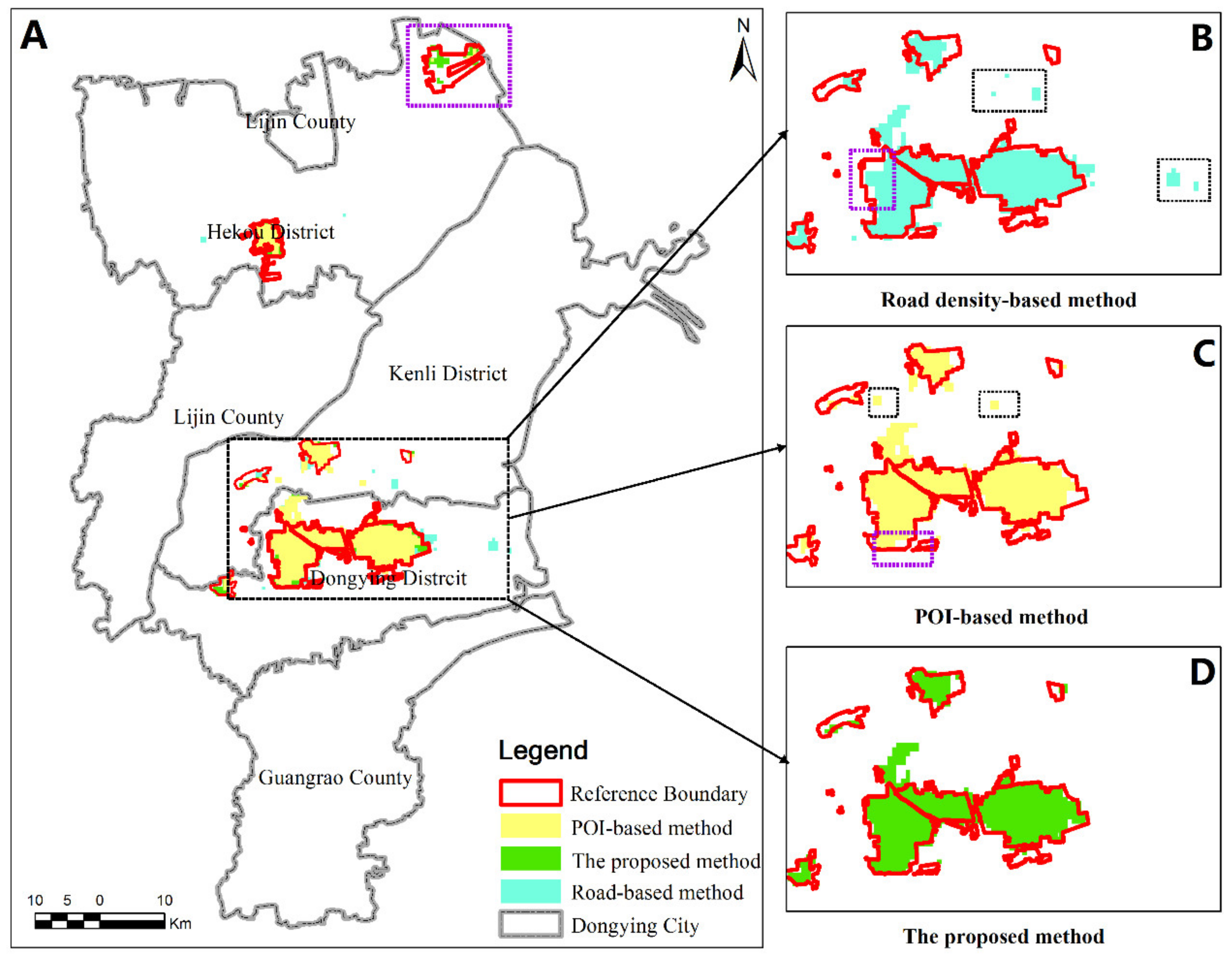
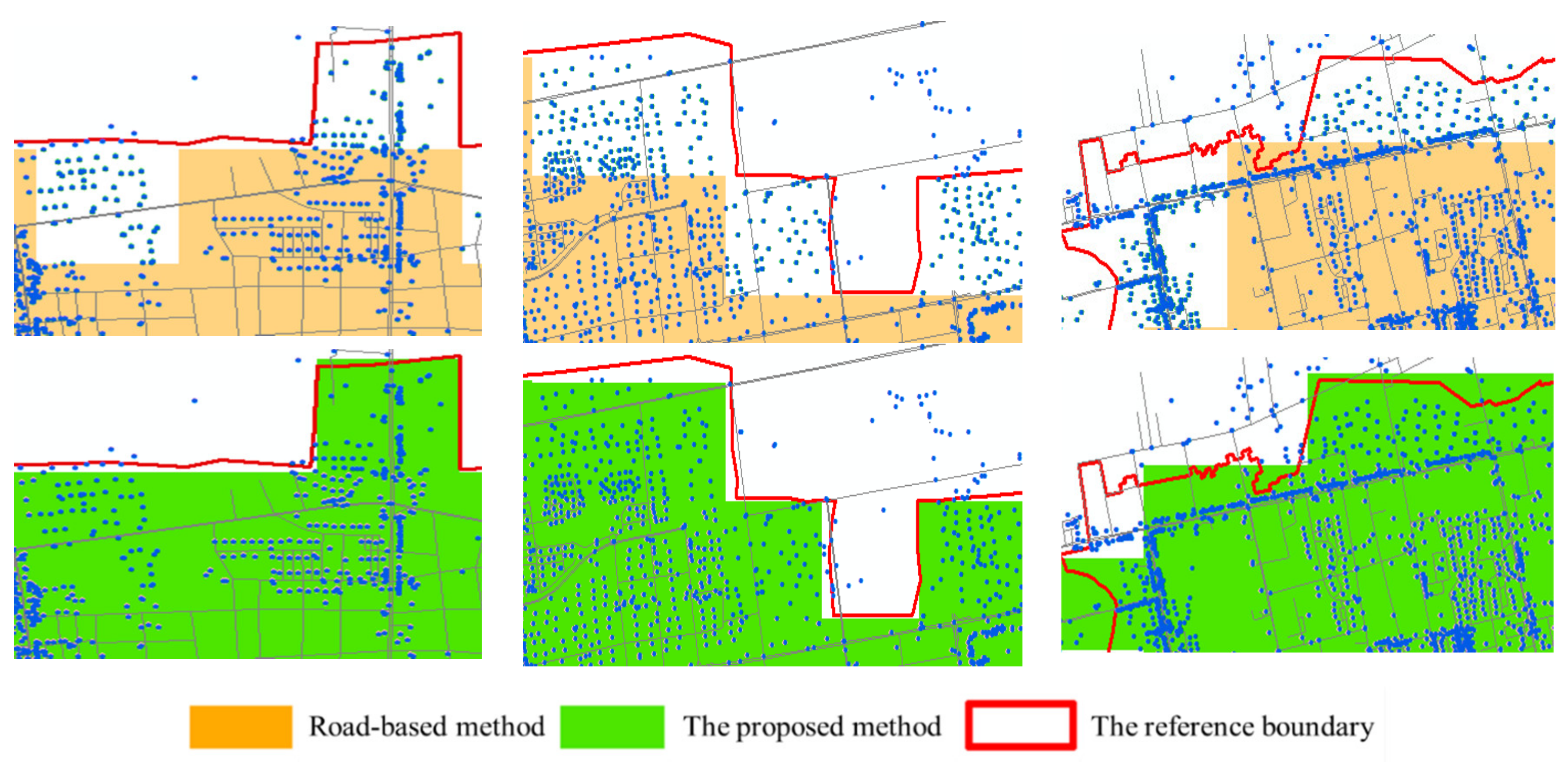
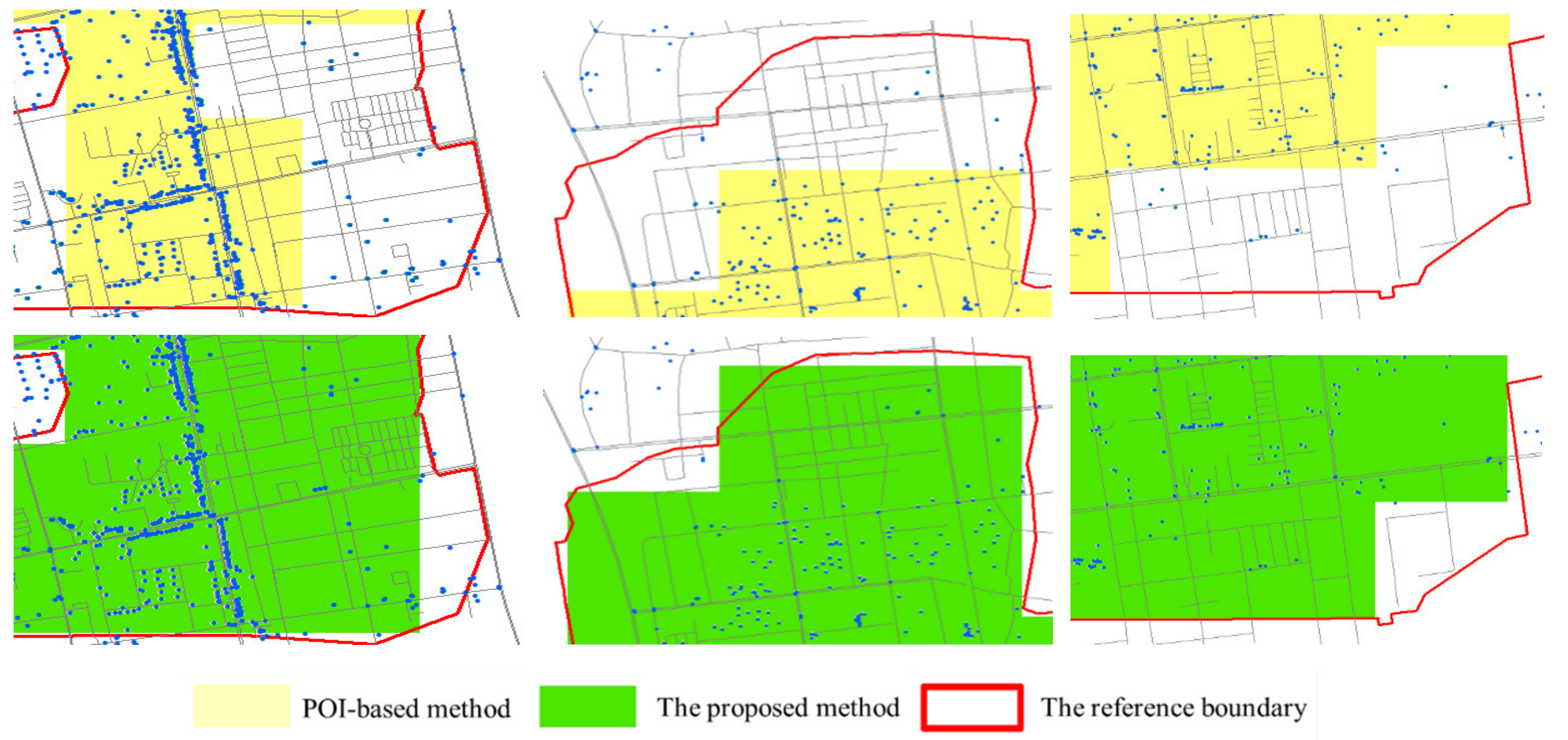
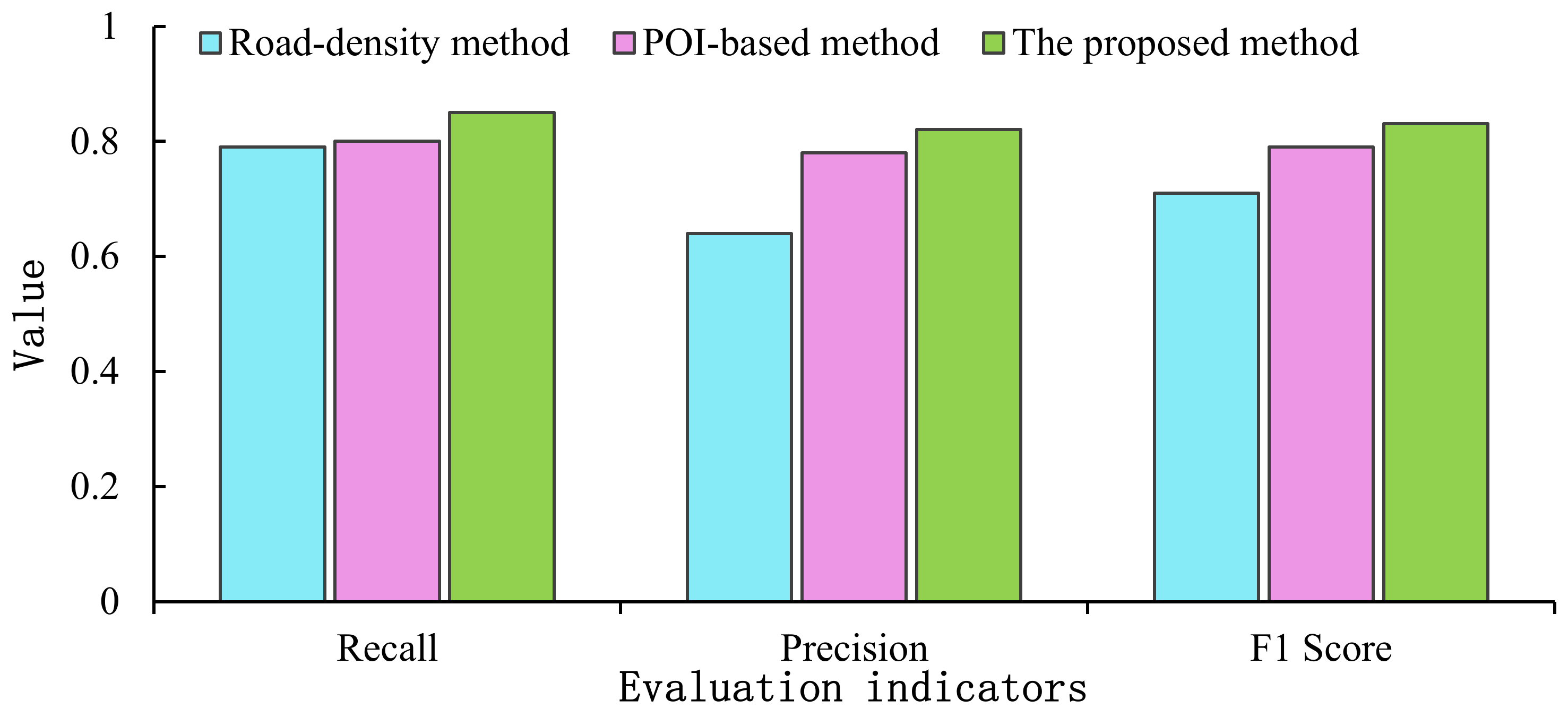
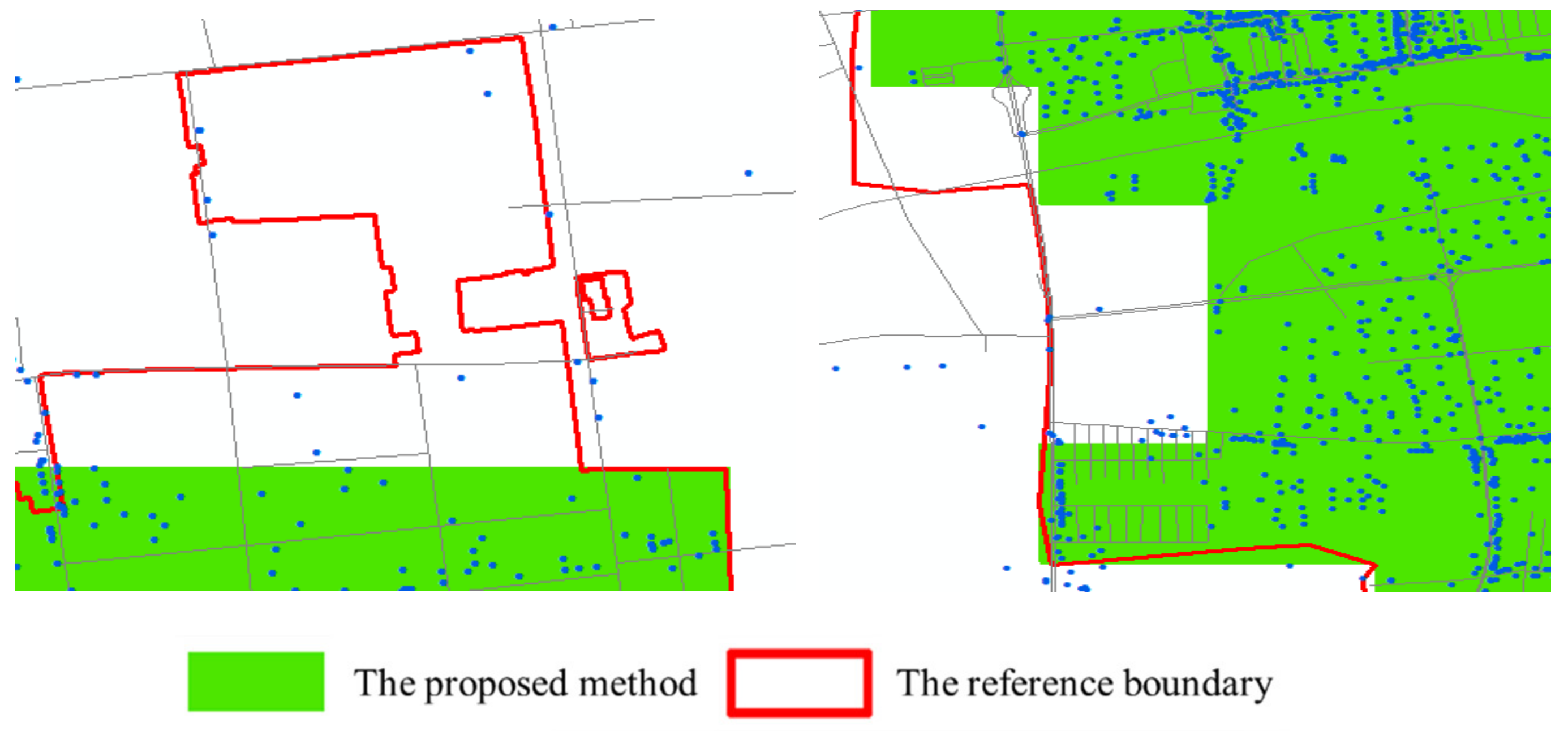
| Method | Extracted UBUA Area (km2) | Absolute Error (%) | Recall | Precision | F1 Score |
|---|---|---|---|---|---|
| Road-based method | 211.5 | 1.05 | 79.1% | 64.2% | 0.71 |
| POI-based method | 208.1 | 0.66 | 80.6% | 78.5% | 0.79 |
| Proposed method | 210.1 | 0.39 | 85.4% | 82.7% | 0.83 |
Publisher’s Note: MDPI stays neutral with regard to jurisdictional claims in published maps and institutional affiliations. |
© 2021 by the authors. Licensee MDPI, Basel, Switzerland. This article is an open access article distributed under the terms and conditions of the Creative Commons Attribution (CC BY) license (https://creativecommons.org/licenses/by/4.0/).
Share and Cite
Li, C.; Wang, X.; Wu, Z.; Dai, Z.; Yin, J.; Zhang, C. An Improved Method for Urban Built-Up Area Extraction Supported by Multi-Source Data. Sustainability 2021, 13, 5042. https://doi.org/10.3390/su13095042
Li C, Wang X, Wu Z, Dai Z, Yin J, Zhang C. An Improved Method for Urban Built-Up Area Extraction Supported by Multi-Source Data. Sustainability. 2021; 13(9):5042. https://doi.org/10.3390/su13095042
Chicago/Turabian StyleLi, Chengming, Xiaoyan Wang, Zheng Wu, Zhaoxin Dai, Jie Yin, and Chengcheng Zhang. 2021. "An Improved Method for Urban Built-Up Area Extraction Supported by Multi-Source Data" Sustainability 13, no. 9: 5042. https://doi.org/10.3390/su13095042





